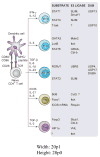Ubiquitin Ligases and Deubiquitinating Enzymes in CD4+ T Cell Effector Fate Choice and Function
- PMID: 27183634
- PMCID: PMC5738552
- DOI: 10.4049/jimmunol.1502660
Ubiquitin Ligases and Deubiquitinating Enzymes in CD4+ T Cell Effector Fate Choice and Function
Abstract
The human body is exposed to potentially pathogenic microorganisms at barrier sites such as the skin, lungs, and gastrointestinal tract. To mount an effective response against these pathogens, the immune system must recruit the right cells with effector responses that are appropriate for the task at hand. Several types of CD4(+) T cells can be recruited, including Th cells (Th1, Th2, and Th17), T follicular helper cells, and regulatory T cells. These cells help to maintain normal immune homeostasis in the face of constantly changing microbes in the environment. Because these cells differentiate from a common progenitor, the composition of their intracellular milieu of proteins changes to appropriately guide their effector function. One underappreciated process that impacts the levels and functions of effector fate-determining factors is ubiquitylation. This review details our current understanding of how ubiquitylation regulates CD4(+) T cell effector identity and function.
Copyright © 2016 by The American Association of Immunologists, Inc.
Figures

References
-
- Pickart CM, Kasperek EM, Beal R, Kim a. Substrate Properties of Site-Specific Mutant Ubiquitin Protein (G76A) Reveal Unexpected Mechanistic Features of Ubiquitin-Activating Enzyme (E1) J Biol Chem. 1994;269(10):7115–7123. - PubMed
-
- Freemont PS, I, Hanson M, Trowsdale J. A Novel Cysteine-Rich Sequence Motif. Cell. 1991;64(3):483–484. - PubMed
-
- Deshaies RJ, Joazeiro CAP. RING Domain E3 Ubiquitin Ligases. Annu Rev Biochem. 2009;78(1):399–434. - PubMed
-
- Scheffner M, Nuber U, Huibregtse JM. Protein Ubiquitination Involving an E1-E2-E3 Enzyme Ubiquitin Thioester Cascade. Nature. 1995:81–83. - PubMed
Publication types
MeSH terms
Substances
Grants and funding
LinkOut - more resources
Full Text Sources
Other Literature Sources
Research Materials

